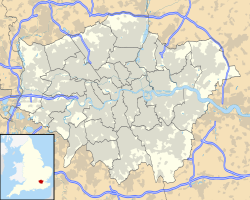Execution Dock
Location of the Execution Dock in Greater London |
The Execution Dock was in the London borough of Wapping on the Thames . It was more than 400 years (until 1830) for the execution of pirates , smugglers and mutineers used by the British Seeger layer to death by hanging were convicted.
history

The Admiralty only had jurisdiction over crimes at sea, so the corresponding dock was within their sphere of influence in the Thames estuary at the high tide mark. The convicts were escorted from Marshalsea Prison across London Bridge behind the Tower before being publicly executed on Execution Dock . The prisoners were brought before their execution with a chaplain to encourage them to confess their sins. They were then taken to the Execution Dock to carry out their sentence.
Delinquents convicted of piracy were hanged on shortened ropes with extreme cruelty. For them this meant a slow death on the gallows by suffocation , as the height of the fall was insufficient to break their necks. It was called "Marshall's Dance" because the extremities of the body often seemed to "dance". After the execution, the bodies were not cut off, as was done when hanging on land, such as in Tyburn . Instead, they usually stayed hanging until at least three floods had passed over their heads. The worst criminals were then tarred and "gibbetiert" at Graves Point (Kent) at the Thames estuary, that is, their corpses were hung on gallows in cages as a deterrent for other pirates.
A report in The Gentleman's Magazine dated February 4, 1796 describes a typical execution on London's Execution Dock:
"Just after 10:00 this morning, Colley, Cole, and Blanche, the three sailors convicted of the murder of Captain Little, were taken out of Newgate and taken in a ceremonial procession to the Execution Dock to be sentenced." of which they had been convicted. There was a raised stage on the wagon on which they were being transported, on which Colley, the murderer in the middle, and his two wretched fellow murderers, the Spaniard Blanche and the mulatto Cole, sat to his left and right, and behind, on another bench, the two executioners .
Colley seemed drugged and barely awake and the two (others) showed little empathy for their situation and didn't want to go to confession in their last lesson. At about a quarter to twelve they were untied in the midst of a huge crowd of spectators.
On the way to their place of execution, the Lord High Admiral drove them in his car and the Vice-Marshal with a silver oar; then the two city marshals followed on horseback, the sheriff's officials, etc. The whole cavalcade moved with great solemnity. "
Well-known Captain Kidd , convicted of piracy and murder, was executed by Newgate Prison in 1701 on Execution Dock. The rope broke during his execution and Kidd was only hanged on the second attempt. His body was then "gibbet" in an iron cage on the Thames for more than 20 years.
George Davis and William Watts were the last convicts to be hanged on the Execution Dock on December 16, 1830.
today
Some sources state that a capital E on the Thames side of the building at Sun Wharf (80 Wapping High Street) indicates where the Execution Dock once stood. Another source gives the approximate former location as the current small subway station, about two-thirds of the way east along Wapping High Street.
literature
- Ben Weinreb, Christopher Hibbert: The London Encyclopedia . Macmillan, 1995, ISBN 0-333-57688-8 , p. 275.
Individual evidence
- ^ The Gentleman's Magazine. February 4, 1796.
- ↑ Google map
- ↑ Guy Macdonald: England . New Holland Publishers, 2004, ISBN 1-86011-116-5 , p. 120.
- ^ Gillian Tindall: Walking Wapping's Streets. New York Times, November 28, 1999.
- ↑ Macdonald and several other sources, including Rocque's map, state that the Execution Dock would have been at the intersection of Brewhouse Lane and Wapping High Street, but the street layout has since been changed so that Brewhouse Lane now runs parallel to Wapping High Street. ( Google map with both presumed locations, as well as the new locations of the New Wapping Stairs and Gun Wharf, both of which appear in Rocque's map )
Coordinates: 51 ° 30 ′ 12 ″ N , 0 ° 3 ′ 26 ″ E

